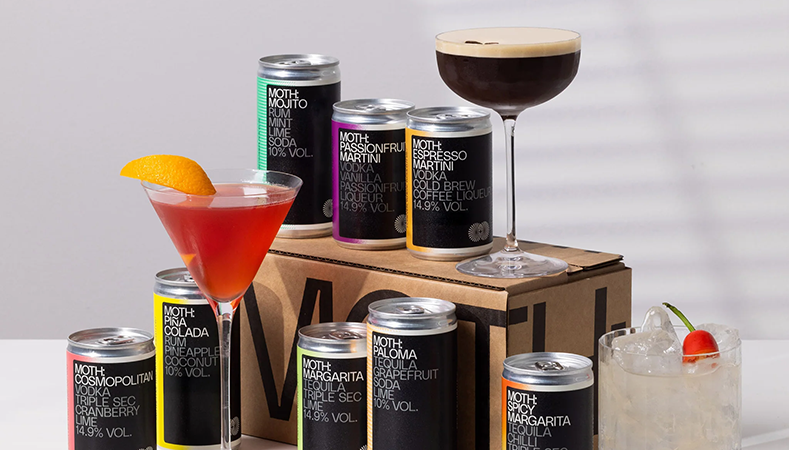
Consumers are increasingly aware of how their use of food and drink products might be negatively impacting our planet which, in turn, puts pressure on companies to be sustainable. At the same time, businesses need to stand out and protect against copycats.
The traditional way of doing this is to come up with a catchy name or logo and maybe even design a unique packaging shape to catch the attention of the consumer and build up brand recognition.
In this sector, given the need to comply with food hygiene regulations and the practicalities of transporting and storing food and drink products, packaging can generally be considered functional – the primary goal being to keep products safe and unspoiled. But when brands take the time to be creative, they can make even everyday products look extraordinary and increase sales and brand buzz in the process, with scope for changing the shape or design of packaging in a way that conveys an eco-friendly message of sustainability.
Protect the product and its packaging with registered designs
One of the quickest and most cost-effective options to protect a product that is often overlooked is design registration which allows protection of the appearance of a product or its packaging, rather than any technical aspects of its function or operation. Whatever it is that makes the product ‘stand-out’ has the capacity to be protected and such protection can be very important in stopping lookalikes.
Registered designs have a very broad definition – ANY appearance of all or part of a product resulting from the lines, contours, colours, shape, texture or materials of the product or its ornamentation, including surface decoration. A design does not need to be considered “artistic” or fall into a category, like copyright to be registrable. However, it must be novel and have individual character, though this is a fairly low threshold.
Whilst unregistered design rights (and copyright) may also arise on creation, they are typically more difficult to enforce so design registration is recommended. Further, the application process for registered designs is quick, simple and inexpensive and gives monopoly protection (i.e. there is no need to prove copying). Registered designs can also be used as the basis for customs applications and take-down requests.
An important point to note is that like patents, a registered design application must be filed before the design is disclosed, although there is a 1 year grace period if needed.
There are some exclusions to design registration, including features of appearance solely dictated by their technical function. So for example, if you have completely re-imagined a packaging design to be more sustainable, patent protection may be more suitable.
What’s in a name? Protect it with a trade mark
The legal definition is that a trade mark can be ANY sign capable of distinguishing the goods or services of one undertaking from those of other undertakings. A trade mark can be any sign that consumers associate with a business; the more traditional being a name or logo but can include colours and 3D shapes amongst other things.
Unregistered trade mark rights start accumulating as soon as you start using a trade mark but given that proving these rights would be entirely evidence based (and so, can be more difficult to enforce) obtaining a trade mark registration is recommended. It’s worth noting that outside the UK some countries give little or no recognition to unregistered rights so registration is strongly recommended. Unlike other forms of IP, trade marks can also last indefinitely provided they are renewed and, like designs, they can be registered with customs and online retailers to take action against counterfeiters.
As well as putting the business in a strong legal position against copycats, obtaining a trade mark is also hugely beneficial from a commercial perspective. Prospective investors or purchasers of a business are sure to ask about any trade mark rights you have and this is likely to affect the valuation. A trade mark is a business asset that can be bought or sold, licensed or mortgaged.
Get creative – sustainability and trade marks
Given that trade marks represent businesses and what they stand for, this can include whether they comply with certain ethical or environmental standards. They make it possible for consumers to reward socially responsible brands with repeat custom, and to avoid and punish those that they might deem to be unethical, for example as a result of their use of unsustainable materials/ingredients or for failing to uphold the human rights of the workers within their supply chain. It’s therefore hugely important to have a brand that communicates positive, ethical values that people buy into and this can be represented by your trade mark.
However, a sign still needs to be distinctive to be registered as a trade mark and there will always be tension between choosing a mark which is gives a clear sustainable message and the trade mark registration system, which will not grant monopolies to descriptive words or slogans.
For example, words like “Natural”, “Organic” and “Plant based” are descriptive and therefore not registrable. However allusive or distinctive words will be registrable, such as Toast (for a beer made from unsold loaves and unused crusts) and Rubies in the Rubble (for a range of condiments made from imperfect fruit & veg that would have otherwise gone to waste).
Giving credibility – third party schemes
An increased sophistication in consumers’ behaviour shows that third party eco-labels offer a competitive edge. There are a multitude of signs you can license to support your sustainability claims and assist consumers in making ethical choices.
Certification Marks – These differ from “ordinary” trade marks because they are not used by the owner but instead serves as a guarantee that the users’ product meets a certain standard, for example food traceability and production standards. The owner of the certification trade mark (usually a trade association) must be competent to certify the goods and monitor compliance with the regulations.
- The Plastic Free logo mark created by A Plastic Planet. Consumers can see this on products or in venues providing services which are free from plastic.
- The Vegan Society’s Vegan trade mark is the leading vegan certification (free from animal ingredients and animal testing) with over 40,000 registered products.
- The Fairtrade logo is a registered certification label for products sourced from producers in developing countries which meet strict standards of the Fair Trade Organisation.
- The Forest Stewardship Council logo identifies wood-based products from well-managed forests independently certified in accordance with the rules of the FSC.
Collective Marks – These are signs of membership. They indicate that the goods or services offered under the mark originate from members of the same trade association.
- Made in Britain is a fast-growing community of like-minded manufacturers. By applying the Made in Britain collective mark a business makes it clear to buyers and consumers that the goods are made in the UK to the very highest standards.
- An example of a collective mark that is used as a tool for promoting sustainable development goals is this logo owned by the Poverty Alleviation Association of Sichuan Province in China. Up to August 2019, it had been used on over 3k products supplied by over 1.5k producers from certified poverty-stricken regions.
Geographical Indications (GI) – A GI enables a named food or drink to be protected against imitation. A GI is a sign used on goods that have a specific geographical origin and possess qualities or a reputation that are due to that origin. Most commonly, a GI consists of the name of the place of origin. As a marketing tool, GIs involve a system of certification and labelling to differentiate products and to highlight the added value of their unique local features, history or distinctive characteristics.
- Welsh Lamb and Welsh Beef which have Protected Geographical Indication status. They demonstrate high standards of animal husbandry and pasture land management.
- Other Eco Labels:
- OPRL scheme – Recognised by the UN Environment Programme as international best practice, and delivers a simple, consistent and UK-wide reuse and recycling message on consumer packaging. RECYCLE means 75% or more of UK local authorities collect that type of packaging which is then effectively sorted, processed and sold as recyclate for use in new packaging or products. DON’T RECYCLE means fewer than 50% of UK local authorities do this.
- Mobius Loop & the green dot – Signify that the packaging producer has made contribution towards packaging recycling.
In Summary
Be proactive and consider how IP protection can support your sustainable business and add value early on. Layer up, think about all the different types of IP that could apply to your business
- Patents: Due to novelty requirements on filing, make sure you consider patent protection early on, looking for any technical effects that might be protectable – this could be a process of production, packaging, or even the composition of a food product. Patent protection can be crucial to gaining that commercial advantage and enabling you to continue with research and development for further sustainable solutions. And remember that even minor advances can be protected, with the ‘inventive’ hurdle not being as high as you may think.
- Designs: Consider if there is something new about the appearance of your product or its packaging which is worth protecting. Like patents consider early on due to novelty requirements. Protecting just part of a product can be very useful, especially if it will be used on multiple items/becomes motif.
- Trade Marks: What aspects of your product or its packaging convey your brand identity and show that you are “sustainable”? Consider licensing the use of certification marks or other third party eco-labels to add credibility.
If you would like to discuss any of the issues raised in this article, then please find my contact details on my web profile here or contact us at gje@gje.com.






